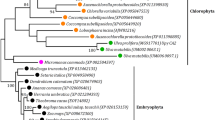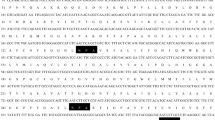Abstract
Carbonic anhydrases (CAs) are a class of zinc-containing metalloenzymes that can reversibly catalyse the hydration reaction of carbon dioxide. Antarctic algae are the most critical component of the Antarctic ecosystem; algae can enter the carbon cycle food chain by fixing carbon dioxide from the air. In this study, the complete open reading frames (ORFs) of CA1 (GenBank ID KY826431), CA2 (GenBank ID KY826432), and CA3 (GenBank ID KY826433), encoding CAs in the Antarctic ice microalga Chlamydomonas. sp. ICE-L, were successfully cloned using reverse transcription-polymerase chain reaction (RT-PCR). In addition, the expression patterns of CAs under blue light, under UV light, and in the dark were determined by quantitative reverse transcription-polymerase chain reaction (qRT-PCR). The CA1, CA2, and CA3 ORFs encode proteins of 376, 430, and 419 amino acids, respectively. Phylogenetic analysis revealed that all amino acid sequences showed high homology with those of C. sp. ICE-L. There are six types of algal CAs; we hypothesised that the CAs studied here are most likely α-CAs. Expression analysis showed that the transcription level of the CAs was influenced by both UV light and blue light. These findings provide additional insight into the molecular mechanisms of CAs and will accelerate the development of CAs for applications in agriculture and environmental governance.




Similar content being viewed by others
References
Kupriyanova, E., Pronina, N., & Los, D. (2017). Carbonic anhydrase—A universal enzyme of the carbon-based life. Photosynthetica, 55(1), 3–19.
NOAA ESRL (2012). National Oceanic and Atmospheric Administration, Earth System Research Laborary. link http://www.esrl.noaa.gov.
Firth, P., Fisher, S. G. (1992). Global Climate Change and Freshwater Ecosystems (pp. 234–249). New York: Springer-Verlag.
Khalifah, R. G. (1971). The carbon dioxide hydration activity of carbonic anhydrase. I. Stop-flow kinetic studies on the native human isoenzymes B and C. Journal of Biological Chemistry, 246(8), 2561–2573.
Stewart, C., & Hessami, M. A. (2005). A study of methods of carbon dioxide capture and sequestration––the sustainability of a photosynthetic bioreactor approach. Energy Conversion and Management, 46(3), 403–420.
Badger, M. (2003). The roles of carbonic anhydrases in photosynthetic CO2 concentrating mechanisms. Photosynthesis Research, 77(2–3), 83.
Zhang, Y. T., Zhang, L., Chen, H. L., & Zhang, H. M. (2010). Selective separation of low concentration CO2 using hydrogel immobilized CA enzyme based hollow fiber membrane reactors. Chemical Engineering Science, 65(10), 3199–3207.
van Hille, R., Fagan, M., Bromfield, L., & Pott, R. (2014). A modified pH drift assay for inorganic carbon accumulation and external carbonic anhydrase activity in microalgae. Journal of Applied Phycology, 26(1), 377–385.
Moroney, J. V., & Somanchi, A. (1999). How do Algae concentrate CO2 to increase the efficiency of photosynthetic carbon fixation? Plant Physiology, 119(1), 9–16.
Tsai, D. D.-W., Chen, P. H., & Ramaraj, R. (2017). The potential of carbon dioxide capture and sequestration with algae. Ecological Engineering, 98, 17–23.
Dimario, R. J., Clayton, H., Mukherjee, A., Ludwig, M., & Moroney, J. V. (2017). Plant carbonic anhydrases—structures, locations, evolution and physiological roles. Molecular Plant, 10(1), 30–46.
Rudenko, N., Ignatova, L., Fedorchuk, T., & Ivanov, B. (2015). Carbonic anhydrases in photosynthetic cells of higher plants. Biochemistry, 80(6), 674–687.
So, A. K.-C., Espie, G. S., Williams, E. B., Shively, J. M., Heinhorst, S., & Cannon, G. C. (2004). A novel evolutionary lineage of carbonic anhydrase (ε class) is a component of the carboxysome shell. Journal of Bacteriology, 186(3), 623–630.
Poole, J. H., Tyack, P. L., Stoeger-Horwath, A. S., & Watwood, S. (2005). Animal behaviour: Elephants are capable of vocal learning. Nature, 434(7032), 455.
Suzuki, K., Yang, S.-Y., Shimizu, S., Morishita, E. C., Jiang, J., Zhang, F., et al. (2011). The unique structure of carbonic anhydrase αCA1 from Chlamydomonas reinhardtii. Acta Crystallographica Section D, 67(10), 894–901.
De Luca, V., Vullo, D., Del Prete, S., Carginale, V., Osman, S. M., AlOthman, Z., Supuran, C. T., et al. (2016). Cloning, characterization and anion inhibition studies of a γ-carbonic anhydrase from the antarctic bacterium Colwellia psychrerythraea. Bioorganic and Medicinal Chemistry, 24(4), 835–840.
Sage, R. F., & Coleman, J. R. (2001). Effects of low atmospheric CO2 on plants: More than a thing of the past. Trends in Plant Science, 6(1), 18–24.
Capasso, C., & Supuran, C. T. (2015). Bacterial, fungal and protozoan carbonic anhydrases as drug targets. Expert Opinion on Therapeutic Targets, 19(12), 1689–1704.
Capasso, C., & Supuran, C. T. (2015). An overview of the alpha-, beta-and gamma-carbonic anhydrases from bacteria: Can bacterial carbonic anhydrases shed new light on evolution of bacteria? Journal of Enzyme Inhibition and Medicinal Chemistry, 30(2), 325–332.
Ozensoy Guler, O., Capasso, C., & Supuran, C. T. (2016). A magnificent enzyme superfamily: Carbonic anhydrases, their purification and characterization. Journal of Enzyme Inhibition and Medicinal Chemistry, 31(5), 689–694.
Lehtonen, J., Parkkila, S., Vullo, D., Casini, A., Scozzafava, A., & Supuran, C. (2004). Carbonic anhydrase inhibitors. Inhibition of cytosolic isozyme XIII with aromatic and heterocyclic sulfonamides: A novel target for the drug design. Bioorganic and Medicinal Chemistry Letters, 14(14), 3757–3762.
Lindskog, S. (1960). Purification and properties of bovine erythrocyte carbonic anhydrase. Biochimica Et Biophysica Acta, 39(2), 218–226.
Lane, T. W., Saito, M. A., George, G. N., Pickering, I. J., Prince, R. C., & Morel, F. M. (2005). Biochemistry: A cadmium enzyme from a marine diatom. Nature, 435(7038), 42.
Sinetova, M. A., Kupriyanova, E. V., Markelova, A. G., Allakhverdiev, S. I., & Pronina, N. A. (2012). Identification and functional role of the carbonic anhydrase Cah3 in thylakoid membranes of pyrenoid of Chlamydomonas reinhardtii. Biochimica et Biophysica Acta (BBA)-Bioenergetics, 1817(8), 1248–1255.
Moroney, J., Bartlett, S., & Samuelsson, G. (2001). Carbonic anhydrases in plants and algae. Plant, Cell & Environment, 24(2), 141–153.
Dionisio, M. L., Tsuzuki, M., & Miyachi, S. (1989). Blue light induction of carbonic anhydrase activity in Chlamydomonas reinhardtii. Plant and Cell Physiology, 30(2), 215–219.
Gao, S., Zhao, W., Li, X., You, Q., Shen, X., Guo, W., Wang, S., et al. (2017). Identification and characterization of miRNAs in two closely related C 4 and C 3 species of Cleome by high-throughput sequencing. Scientific Reports, 7, 46552.
Ynalvez, R., Xiao, Y., Ward, A., Cunnusamy, K., & Moroney, J. (2010). Identification and characterization of two closely related beta-carbonic anhydrases from Chlamydomonas reinhardtii. Physiologia Plantarum, 133(1), 15–26.
An, M., Mou, S., Zhang, X., Ye, N., Zhou, Z., Cao, S., et al. (2013). Temperature regulates fatty acid desaturases at a transcriptional level and modulates the fatty acid profile in the Antarctic microalga Chlamydomonas sp. ICE-L. Bioresource Technology, 134(2), 151–157.
He, Y., Wang, Y., Zhou, Z., Liu, F., An, M., He, X., et al. (2017) Cloning and stress-induced expression analysis of calmodulin in the antarctic alga Chlamydomonas sp. ICE-L. Current Microbiology, 1–9.
Thompson, J. D., Gibson, T. J., Plewniak, F., Jeanmougin, F., Higgins, D. G. (1997) The ClustalX windows interface: Flexible strategies for multiple sequence alignment aided by quality analysis tools. Nucleic Acids Research, 25(25), 4876–4882.
Felsenstein, J. (1985). Confidence limits on phylogenies: An approach using the bootstrap. Evolution, 39(4), 783–791.
Livak, K. J., & Schmittgen, T. D. (2001). Analysis of relative gene expression data using real-time quantitative PCR and the 2– ∆∆CT method. Method, 25(4), 402–408.
Waterhouse, A., Bertoni, M., Bienert, S., Studer, G., Tauriello, G., Gumienny, R., et al. (2018) SWISS-MODEL: Homology modelling of protein structures and complexes. Nucleic Acids Research.
Sumi, K. R., Nou, I.-S., & Kho, K. H. (2016). Identification and expression of a novel carbonic anhydrase isozyme in the pufferfish Takifugu vermicularis. Gene, 588(2), 173–179.
Coviello, V., Marchi, B., Sartini, S., Quattrini, L., Marini, A. M., Simorini, F., Taliani, S., et al. (2016). 1, 2-Benzisothiazole derivatives bearing 4-, 5-, or 6-alkyl/arylcarboxamide moieties inhibit carbonic anhydrase isoform IX (CAIX) and cell proliferation under hypoxic conditions. Journal of Medicinal Chemistry, 59(13), 6547–6552.
Engel, B. D., Schaffer, M., Cuellar, L. K., Villa, E., Plitzko, J. M., & Baumeister, W. (2015). Native architecture of the Chlamydomonas chloroplast revealed by in situ cryo-electron tomography. Elife, 4, e04889.
Qu, C., He, Y., Zheng, Z., An, M., Li, L., Wang, X., He, X., et al. (2018). Cloning, expression analysis and enzyme activity assays of the α-carbonic anhydrase gene from Chlamydomonas sp. ICE-L. Molecular Biotechnology, 60(1), 21–30.
Benlloch, R., Shevela, D., Hainzl, T., Grundström, C., Shutova, T., Messinger, J., Samuelsson, G., et al. (2015) Crystal structure and functional characterization of photosystem II-associated carbonic anhydrase CAH3 in Chlamydomonas reinhardtii. Plant Physiology, 167(3):950–962.
Dedeoglu, N., De Luca, V., Isik, S., Yildirim, H., Kockar, F., Capasso, C., & Supuran, C. T. (2015). Cloning, characterization and anion inhibition study of a β-class carbonic anhydrase from the caries producing pathogen Streptococcus mutans. Bioorganic and medicinal chemistry, 23(13), 2995–3001.
Supuran, C. T. (2017). Advances in structure-based drug discovery of carbonic anhydrase inhibitors. Expert Opinion on Drug Discovery, 12(1), 61–88.
Supuran, C. T. (2008). Carbonic anhydrases: Novel therapeutic applications for inhibitors and activators. Nature Reviews Drug Discovery, 7(2), 168–181.
Acknowledgements
This work was supported by the National Key Research and Development Program of China (Grant No. 2018YFD0900705; 2018YFD0901103), the Natural Science Foundation of China (Grant Nos. 41576187, No. 41776203, No. 21576145), Key Research and Development Program of Shandong Province (Grant Nos. 2016YYSP017, No. 2016ZDJS06A03, No. 2017GHY15112, No. 2018YYSP024, Grant No. 2018GHY115034), Public Science and Technology Research Funds Projects of Ocean (Grant No. 201405015), Deep Sea Biological Resources Plan of China (Grant No. DY135-B2-14), Qingdao Entrepreneurship & Innovation Pioneers Program (Grant No. 15-10-3-15-(44)-zch), and Ningbo Public Service Platform for High-Value Utilization of Marine Biological Resources (Grant No. NBHY-2017-P2).
Author information
Authors and Affiliations
Corresponding author
Ethics declarations
Conflict of interest
The authors declare that they have no conflict of interest.
Ethical Approval
This article does not contain studies with animals.
Additional information
Publisher’s Note
Springer Nature remains neutral with regard to jurisdictional claims in published maps and institutional affiliations.
Electronic supplementary material
Below is the link to the electronic supplementary material.
Rights and permissions
About this article
Cite this article
Shi, C., An, M., Miao, ·. et al. Isolation and Expression Analysis of Three Types of α-Carbonic Anhydrases from the Antarctic Alga Chlamydomonas sp. ICE-L under Different Light Stress Treatments. Mol Biotechnol 61, 200–208 (2019). https://doi.org/10.1007/s12033-018-00152-4
Published:
Issue Date:
DOI: https://doi.org/10.1007/s12033-018-00152-4




